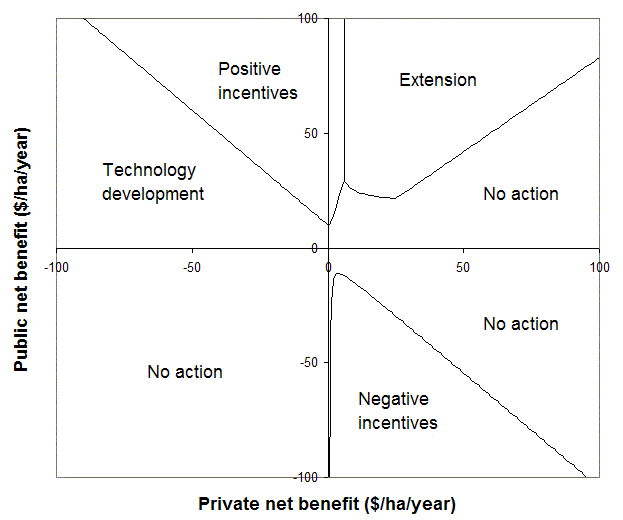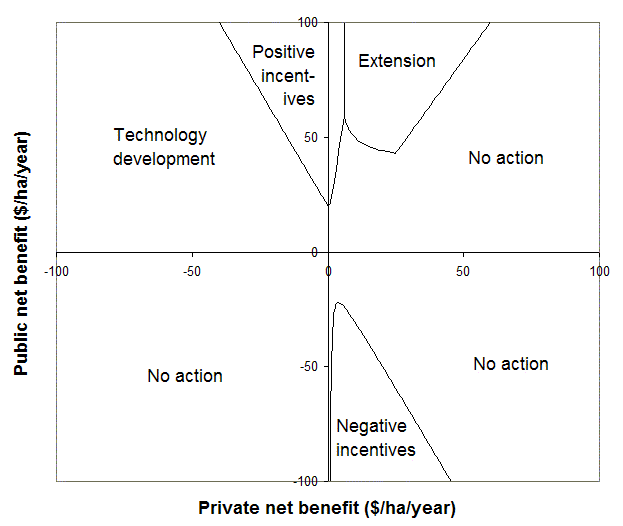80 – Public benefits, private benefits: the final framework
This is the seventh and final instalment of a series that examines a simple framework for choosing environmental policy instruments, as outlined in PD#73. The framework is based on levels of public and private net benefits of changing land management, and a set of simple rules. This time we pull together refinements developed for each part of the framework over the past five Pannell Discussions, and present a revised version of the overall framework.
In PD#73 I showed how a set of simple and reasonable rules can lead to a useful map of efficient policy instruments. The context is an environmental manager considering prospective projects to change land use in particular ways on particular pieces of private land. The map shows that the choice of instruments depends crucially on the levels of public and private net benefits from those projects. A particular project to change land use in particular ways on particular pieces of land would be represented by a dot somewhere on Figure 1. Depending on where the various dots lie, different types of policy response are recommended.
In the past five Pannell Discussions we have looked in more detail at the individual areas of the map, and refined its recommendations. This article pulls together those refinements to present a revised overall framework.
The refined map shown in Figure 1 is based on environmental managers requiring a benefit:cost ratio (BCR) of at least 1.0 in order to invest in incentives or extension.
Figure 1. Efficient policy mechanisms for encouraging land use on private land, refined according to PD#75, PD#76 and PD#78, assuming managers require BCR > 1.
In broad terms, the framework indicates the use of:
- positive incentives if the public net benefits of land-use change are high, and the private net benefits are not too negative;
- extension if the public net benefits of land-use change are high, and the private net benefits are moderate;
- no action if private net benefits are positive and public net benefits are not sufficiently high;
- no action if private net benefits are greater than public net costs;
- negative incentives if private net benefits are less than public net costs;
- no action if public net benefits and private net benefits are both negative;
- technology development if private net benefits are negative and public net benefits are not sufficiently high to warrant incentives;
Figure 1 is broadly similar to the original map in PD#73, with the main difference being in the extension area, which is more targeted to projects with higher public net benefits or lower but still positive private net benefits.
Figure 2 shows a comparable diagram based on a required BCR of at least 2.0, which is probably a more reasonable guide to investment than Figure 1, given that program resources are limited and there are more worthwhile projects available than the program can afford to fund. (Also, we might need a BCR of at least 2 to outweigh the overhead costs of running the program.) This more targeted strategy shows that, broadly speaking, the higher priority projects are those where private net benefits are closer to zero, and/or public net benefits are more extremely positive or negative.
Figure 2. Efficient policy mechanisms for encouraging land use on private land, refined according to PD#75, PD#76 and PD#78, assuming managers require BCR > 2.
A much smaller number of projects would qualify for incentives or extension in the more targeted approach of Figure 2. For example, over 35% of the area of Figure 1 is occupied by incentives or extension, whereas in Figure 2, they occupy less than 15%. If we allow for the reality that most projects involve negative private net benefits, the proportion qualifying as high-priority targets for intervention is lower again.
As noted in PD#78, most agricultural land probably falls into the technology development area. For most land, the best available environmental projects involve negative private net benefits and positive, but not extremely high, public net benefits. This highlights the important role of technology development. It has been relatively neglected in current programs.
Finally some general observations about the framework. The recommendations in Figures 1 and 2 (like all of the recommendations in the framework) depend on the landholders having reasonably accurate perceptions about the private net benefits of adoption. If this is not true, there may be roles for extension, positive incentives or negative incentives in other parts of Figures 1 and 2.
It is notable that the choice of policy response depends at least as much on the level of private net benefits from the land-use change as on the public net benefits. Indeed, in the more targeted version in Figure 2, results are even more sensitive to private than to public net benefits. This is an important finding as many environmental managers focus predominantly on the public benefits, but pay little attention to the estimation of private net benefits. As a consequence, they are under-informed about the landholders’ likely responses to any proposed changes in land use, which is one of the key factors that should influence the choice of policy response.
This begs the question, how should environmental managers estimate the costs and benefits? A glib answer is, “as best they can”. In the case of public net benefits, the framework does not require environmental managers to do things that they should not already be doing. Somehow they are choosing which environmental projects are of highest priority, so there must be some assessment of the environmental benefits, even if only implicitly. It is unrealistic to expect that projects could be ranked according to their environmental benefits with any great precision, but even relatively qualitative ratings could be applied within this framework.
To estimate private net benefits, one option is to invest in some good quality economic modelling. Another is to look at what farmers are currently doing. If they are choosing not to adopt a practice that has been around for a while and with which they are familiar, this provides a strong indication of their assessment of its private net benefits (including issues beyond just short-term financial returns). A third option is to run a conservation auction, in which landholders reveal their willingness to act in response to a subsidy level chosen by them.
It is important to recognise that both categories of net benefits depend on several elements. The public net benefits are not simply the value of the environmental assets involved, and the private net benefits are not simply the profits from the new land use. Indeed, the private net benefits of a project (i.e. a specific set of land-use changes) would depend on:
- the financial returns from the new land uses;
- the financial returns from the land uses that are replaced (the “opportunity costs”);
- any change in risks faced as a result of the change;
- indirect impacts on other aspects of the farm system or on the farmer’s lifestyle;
- the farmer’s own interest in the environmental outcomes.
The public net benefits would depend on:
- the value or importance of the environmental assets that are affected by the changes;
- the degree of degradation that the assets were facing or had already suffered;
- the extent to which that degradation can be prevented or alleviated by the changes;
- any lags in the response of the biological or physical system to the land-use changes.
Overall, the framework highlights the importance of targeting funds in environmental programs to selected areas, based on the levels of public and private net benefits. Currently, environmental managers do pay some attention to the level of public benefits when selecting their investments, but in my experience few pay adequate attention to the level of private net benefits, which, perhaps surprisingly, turns out to be even more important as a driver of policy decisions.
David Pannell, The University of Western Australia
Further Reading
A consolidated paper on the public benefits, private benefits framework (combines all seven related Pannell Discussions): Public benefits, private benefits, and the choice of policy tool for land-use change

